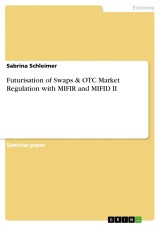Details

Futurisation of Swaps & OTC Market Regulation with MIFIR and MIFID II
1. Auflage
|
CHF 17.00 |
|
| Verlag: | Grin Verlag |
| Format: | |
| Veröffentl.: | 20.08.2018 |
| ISBN/EAN: | 9783668776579 |
| Sprache: | englisch |
| Anzahl Seiten: | 11 |
Dieses eBook erhalten Sie ohne Kopierschutz.
Beschreibungen
Seminar paper from the year 2018 in the subject Business economics - Investment and Finance, grade: 1,0, University of Strathclyde (Business School), course: Derivatives and Treasury Management, language: English, abstract: The necessity of increased stabilisation and regulation of financial markets, especially over-the-counter markets, has received increased international attention following the financial crisis of 2007-08.1 Previously, swap markets were largely ‘in the dark’ when compared to exchange traded derivatives. The reactionary regulation, the Dodd-Frank Act, has severely tightened the OTC swaps markets through standardisation, increased collateral requirements and reporting standards and a more refined clearing mandate; to continue our analogy, it has sought to bring the swaps market into the light. Due to this increased regulation and subsequent increased costs associated with trading swaps, large swathes of swap trading migrated onto futures exchanges, in a process known as swap futurisation. This offered market participants regulatory certainty as well as a reduction in some of the more onerous costs and requirements under the Dodd-Frank Act. With eight years of trading under the Dodd-Frank regulation, our investigation into the advantages and disadvantages of swap futurisation will focus on trends seen in American data. Following on we will look more closely at the European Union’s response, namely the Markets in Financial Instruments Directive II and the Markets in Financial Instruments Regulation.
Diese Produkte könnten Sie auch interessieren:

Die Festlegung von Wesentlichkeitsgrenzen im Rahmen der Abschlussprüfung

von: Elina Valpetere

CHF 19.00















